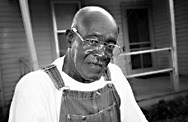LESTER DOWDEY
Alcoa, Tennessee
Lester Coleman Dowdey made his first “limberjack” when his six-year-old niece Angela Cooper had a toothache. Using some discount paint and scrap lumber from the Lowes Building Materials where he worked, Dowdey created a puppet character with a sore tooth. Making the figure dance to his harmonica seemed to have a curative effect on the young Angela.
Word about his healing puppet travelled quickly throughout his neighborhood in Alcoa, Tennessee. Soon he was making varied puppets to cure ulcers, forgetfulness, arthritis, and other ailments. His most commonly used puppet was one he calls “Mr. Stop Smoking.”
Lester Dowdey’s uncle J. C. Burris had made limberjacks but used them to tell stories, often performing with them while playing his harmonica at folk music festivals. Unlike his uncle, Dowdey was never a professional musician.
Lester Coleman Dowdey’s limberjack puppets are an example of what anthropologists call “sympathetic magic,” which is based on the metaphysical belief that “like affects like.” It is the basis for most forms of divination, from palmistry and voodoo to the concept of karma. Even the Catholic practice of Communion to infuse the participant with divinity is a form of sympathetic magic.
Some anthropologists consider magical thinking a precursor to scientific thinking. It is indicative of a human concern with control over nature through understanding cause and effect. Examples of magical divination may be found in ancient India, Babylon, Egypt, Greece and Rome.
In 1989, Dowdey made a puppet to try and cure Willa Mae Polk of breast cancer. Despite her prior surgery and chemotherapy, Ms. Polk died three hours after Lester Dowdey’s limberjack danced at the foot of her bed. Feeling responsible for her death, he considered burning all of his puppets.
Instead, the following week he sold twenty of his limberjacks to George and Helen Spelvin.
TO VIEW THE WORKS OF LESTER COLEMAN DOWDEY, CLICK HERE.
